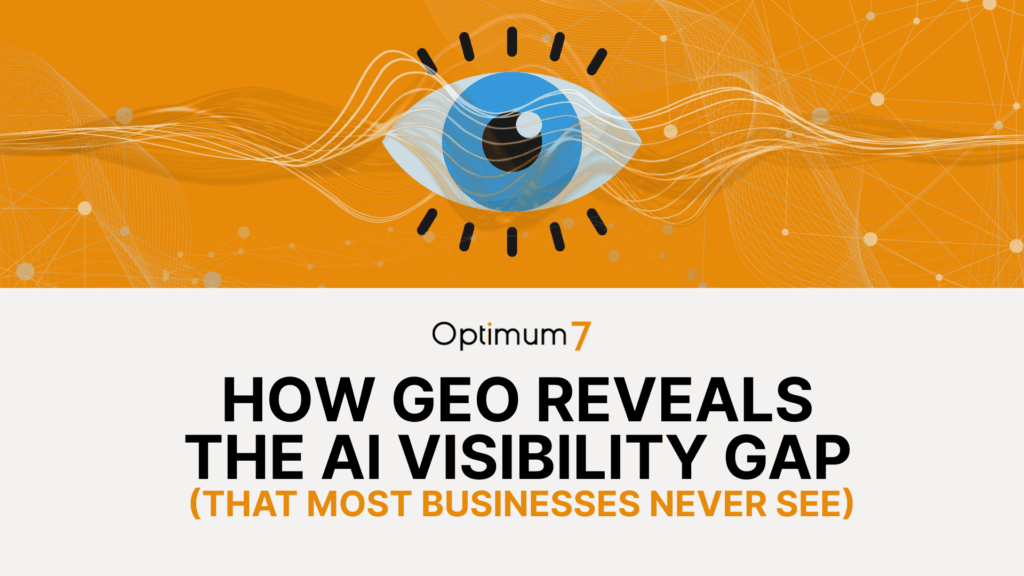The New Front Door of Ecommerce
Not long ago, product discovery followed a predictable path. Someone needed running shoes, or a camera, or a new set of noise-canceling headphones. They went to Google, typed a phrase, scrolled past a few ads, and clicked through to compare product pages. Or they went straight to Amazon, skimmed the top results, and trusted the reviews. That was the funnel. Traffic flowed through search engines and marketplaces, and brands fought for visibility by mastering SEO or gaming marketplace algorithms.
But look at how that same search happens today. A consumer opens ChatGPT or Gemini and types: “What’s the best camera under $1,000 for travel?” They don’t get a list of links. They don’t scroll through page two of Google results. They get a conversation. They get one or two clear recommendations, wrapped in context, phrased like a trusted advisor giving advice.
That shift is dramatic. The first touchpoint in product discovery is no longer a search results page—it’s a chatbot. And that means the entire game of visibility has changed. If your product isn’t inside that answer, if your brand isn’t part of that conversation, you’re invisible.
For ecommerce owners and marketers, this isn’t a side trend. It’s the new front door. Customers aren’t waiting to click into your product page anymore; they’re making purchase decisions inside the dialogue itself. ChatGPT is the shelf. Gemini is the display case. Perplexity is the aisle. And if your product doesn’t show up there, someone else’s will.
The uncomfortable truth is that the strategies that worked for two decades—keyword optimization, marketplace hacks, paid placements—are losing ground. They’ll still matter, but they’re no longer enough. AI recommendation engines don’t rank ten blue links. They choose winners and losers in real time, based on authority, context, and the data they’ve been trained on.
This article is about what that means for you. It’s not about chasing hacks or tricking the model with clever prompts. It’s about building a strategy that gets your products recommended by AI the same way you once fought to get them on the first page of Google. Because in the coming years, when a customer asks a chatbot what to buy, the only products that matter are the ones it speaks out loud.
The Old Playbook Is Losing Its Power
For years, visibility was a math problem. You stuffed the right keywords into a product page, optimized the title tags, sprinkled in some backlinks, maybe threw budget into ads, and you were on the map. If you sold on Amazon, you learned the quirks of its ranking system; how sales velocity, reviews, and pricing nudged you toward the top. It wasn’t perfect, but it was predictable.
That predictability is gone. Today, someone asks, “What’s the best protein powder for runners?” and ChatGPT gives two options, maybe three. Notice what’s missing? The long list of alternatives, the scroll, the entire marketplace of possibilities. One answer is highlighted. Everything else is erased.
This is the first real crack in the old SEO mindset. Traditional search rewarded breadth. Ten organic spots, dozens of ads, page after page of results. Even if you weren’t number one, you could still claw your way into the game. With AI-driven conversations, there is no “page two.” There’s a spotlight, and you’re either in it or you’re not.
And this is where the old tricks start to feel flimsy. Keyword stuffing doesn’t convince a language model. Paid ads don’t guarantee visibility when a chatbot is asked for a recommendation. Even marketplace optimization has limits because while Amazon is still powerful, consumers are learning they don’t need to dig through endless reviews when a chatbot can distill the research in a single sentence.
That doesn’t mean SEO is dead. It means the shape of it has changed. The battlefield isn’t just about climbing Google’s results anymore—it’s about feeding the sources that AI trusts, shaping the ecosystem that language models learn from. If you’re still playing the old game, you’re fighting for visibility on a stage fewer and fewer buyers are standing on.
Understanding AI as the New Gatekeeper
Search engines used to act like librarians. You asked a question, they handed you a stack of books, and it was up to you to dig through the pile. Conversational AI doesn’t play that role. It isn’t a librarian, it’s the advisor sitting across the table. Instead of giving you every option, it makes a recommendation. That small difference changes everything.
When a customer asks ChatGPT, “What’s the best electric toothbrush under $200?”, the model doesn’t think like a search index. It pulls from training data, from recently crawled product content, from reviews, from forums, from anything in its dataset that seems credible. It blends authority with context, and then it speaks back a few options as if it were a trusted friend. There’s no scroll, no sidebar ads, and no second chance if you’re not mentioned.
Why do people trust it? Because the answer feels curated. It feels personal. Unlike Google, which forces you to wade through ten results and decide, AI makes the choice for you. That decision-making, once left to the consumer, now sits in the hands of the model.
For businesses, this is the new reality: AI has become the gatekeeper of product visibility. The customer journey often begins—and sometimes ends—inside a conversation. And the brutal truth is this: if your product isn’t in the model’s field of vision, you don’t just rank lower. You disappear.
This is why the conversation around “ChatGPT SEO” matters. It’s not about tricking a chatbot. It’s about making sure the ecosystems that feed these models—your site, your reviews, your presence across the web—are rich enough, trusted enough, and visible enough to surface when the model makes its call.
The brands that grasp this shift early will dominate AI-driven discovery. Everyone else will keep shouting into Google’s old megaphone while the real buying conversations happen somewhere else.
What “ChatGPT SEO” Actually Means
The phrase itself, ChatGPT SEO, sounds like a gimmick. Like some new hack, another checklist that promises quick wins. But that’s the wrong way to think about it. You don’t optimize for a chatbot by stuffing prompts or gaming the interface. You optimize by feeding the ecosystem that the model draws its answers from.
When ChatGPT recommends a skincare brand or Gemini suggests a bike helmet, it isn’t pulling from thin air. It’s pulling from content that exists in the wild: product descriptions on your site, comparison articles written by reviewers, long Reddit threads debating pros and cons, YouTube videos walking through unboxings, and schemas and structured data telling machines exactly what a product does. All of it mixes together to form the foundation of what AI “knows.”
That means ChatGPT SEO isn’t about the chatbot itself. It’s about ensuring your brand has enough visibility, authority, and context in the sources these models trust. Think about it less like traditional keyword SEO and more like reputation building, instead of fighting for a rank on a search results page, you’re training the AI to see your product as relevant, reliable, and worth recommending.
And there’s no shortcut. You can’t buy your way into a language model’s recommendation engine the same way you can with Google Ads or sponsored marketplace placements. You earn your way in through better content, more authentic customer signals, and stronger technical infrastructure.
For marketers who have lived inside the familiar world of search rankings, this feels foreign. But in reality, it’s just the natural evolution of SEO. The difference is that the stakes are higher. Instead of fighting for one of ten blue links, you’re fighting for a single mention in a single answer. Which means authority, trust, and context aren’t nice-to-haves anymore. They’re the only things that matter.
Building AI-Ready Product Content
The easiest way to get buried by AI is to treat your product descriptions like afterthoughts. A couple of generic lines about “high quality” or “best in class” won’t even register. ChatGPT isn’t impressed by filler; it pulls answers from content that actually speaks to customer questions.
Think about how people phrase their queries. They don’t type “water bottle double wall insulation buy.” They ask, “What’s the best leak-proof water bottle for hiking?” If your product page doesn’t answer that exact scenario—hikers worried about leaks, looking for durability—you’re invisible. AI isn’t guessing; it’s matching patterns. The closer your content mirrors how buyers talk about their needs, the more likely your product is to surface.
That means product pages need depth. Not length for the sake of length, but substance. Spell out the use cases: who it’s for, when it shines, and what problem it solves better than the alternatives. Don’t just say “lightweight.” Say, “We engineered it for trail runners who hate bulky gear.” That framing becomes the connective tissue AI uses to tie your product to specific buyer questions.
Comparison content is another lever. Shoppers constantly ask ChatGPT to weigh options—this model versus that one, brand A versus brand B. If you don’t write those comparisons yourself, someone else will, and the AI will lean on their version of the story. Honest, balanced comparisons not only capture more queries, they signal to the model that your brand is an authority in the category.
And here’s the part most brands miss: authenticity isn’t optional anymore. AI loves real voices. It scrapes reviews, testimonials, and even forum threads. If all your product content sounds like marketing copy, it blends into the noise. But when real customers say, “This camera handled low-light shots better than my old Canon,” that sentence carries weight. Build ways to surface and showcase those voices, because the models are listening.
The brands that will win aren’t the ones that churn out the most content. They’re the ones who produce the most relevant content, the pages that sound like answers to real questions. In the AI era, that’s the new visibility.
Structured Data: Speaking the Language of AI
Language models thrive on context. They don’t just look at words; they look at signals—how data is structured, how consistent it is across the web, and whether it can be trusted as fact. This is where structured data comes into play. If product content is how you talk to buyers, schema markup and catalog feeds are how you talk to machines.
Think of schema as subtitles for your products. You might describe a pair of headphones as “lightweight” and “wireless,” but unless you tag those details properly, AI crawlers might not connect them to the buyer query “best wireless headphones for travel.” Schema markup tells the machine, “This is the price, this is the weight, this is the battery life, and these are verified reviews.” It strips away ambiguity and gives the model certainty.
The same goes for catalog feeds. Google Merchant Center, Amazon product listings, and Walmart Connect—they’re not just sales channels anymore; they’re training grounds. Conversational AIs pull structured product information directly from these sources. If your feeds are sloppy, outdated, or inconsistent, you’re handing competitors the advantage. Freshness matters. Outdated or inconsistent data is less likely to be trusted or surfaced by AI systems. A product page last updated two years ago is less likely to be trusted than one updated last week.
And here’s a subtle but important point: structured data isn’t only about being found. It’s about being ranked within the model’s trust system. AI is less likely to recommend products if the underlying details don’t line up across the web. If your pricing says one thing on your site and another on Amazon, or if your product specs are incomplete, the inconsistency makes the model hesitate. And hesitation means invisibility.
The companies that get this right treat structured data as part of their marketing stack, not a technical afterthought. They invest in clean feeds, proper schema, and automated systems that keep everything current. If the machines don’t fully understand your product, they won’t recommend it.
External Validation: Owning the Ecosystem Around Your Product
If structured data is the clean language you use to talk to machines, external validation is the messy, human chorus that machines actually believe. AI doesn’t just scrape your product page and take your word for it. It listens to what everyone else is saying on Reddit threads, Quora answers, YouTube reviews, TikTok demos, and even blog posts from niche experts.
This is where many brands stumble. They polish their own site to perfection but forget that the model isn’t just reading their marketing copy; it’s cross-checking it against the wider web. If customers complain about durability on forums, or if a competitor dominates YouTube comparisons, the AI absorbs that and weighs it. When a shopper asks, “Which standing desk is best for home offices?” the recommendation reflects the consensus, not just the manufacturer’s claims.
That means visibility is about planting seeds across the ecosystem. The more authentic mentions you have in credible third-party spaces, the stronger your brand’s footprint becomes in AI’s eyes. Reviews matter, not because a human might read them, but because language models ingest them. Influencer videos matter, not because of direct clicks, but because they feed the model narratives it repeats later.
Here’s the uncomfortable part: you can’t fully control this. You can only influence it. Which is why authenticity is everything. Paid reviews or staged “user content” doesn’t work long-term; the models pick up on patterns. What does work is encouraging real users to share, incentivizing honest reviews, seeding experts with your products, and building authority in conversations you don’t own.
Think of it this way: every piece of content about your product—on your site, on someone else’s site, on a social platform—is another breadcrumb. AI follows those trails, pieces them together, and decides whether you’re worth mentioning. The brands that dominate recommendations won’t just have strong product pages. They’ll have a web of validation around them that makes their authority undeniable.
Technical Infrastructure for AI Visibility
Even in an AI-driven discovery world, the foundation still matters. If your site loads slowly, if pages break on mobile, or if content is duplicated across multiple URLs, you’re handicapping yourself before the conversation even begins. Large language models don’t pull only from abstract data pools—they crawl the web, index your site, and weigh its reliability just like search engines always have.
That means site health isn’t optional. Product pages need to be crawlable, consistent, and up-to-date. Thin or outdated pages aren’t just bad for customers—they give models less confidence in your brand. Freshness counts. A product description revised last month signals relevance. A description untouched for five years tells the model you’re not actively maintaining your information, so AI systems are less likely to trust or surface that page.
Category structure plays a role too. AI thrives on semantic strength—the ability to see that your product isn’t just an item but part of a larger ecosystem. If your site builds out content hubs around themes like “trail running gear” or “ergonomic office furniture,” the model sees stronger connections between your products and the questions people ask. Without that structure, your brand is just another isolated page in a sea of noise.
At a deeper level, consistency across systems is what builds trust. Your ERP, your e-commerce platform, and your merchant feeds—if they all tell the same story about price, availability, and specs, AI has no reason to doubt it. If the signals conflict, it will pick the competitor with cleaner data.
Infrastructure isn’t glamorous, but it’s the scaffolding that keeps your visibility intact. The brands that get lazy here—slow sites, neglected product catalogs, messy feeds—will slowly disappear from recommendations, not because their products are worse, but because the machines can’t rely on them.
Measuring Success in the AI Era
For two decades, marketers have lived and died by rankings. Where you sat on Google’s first page, what your click-through rates looked like, how much traffic you pulled from organic search. Those numbers built entire careers. But when product discovery moves inside AI conversations, the scoreboard changes.
The hard part is that most of the old metrics don’t translate. There’s no “position two” in ChatGPT. There’s no click-through rate when a chatbot tells the customer, “Here are the two best options.” Visibility in this new world is binary—you’re either mentioned or you’re not. That makes measurement trickier, but not impossible.
What starts to matter are signals of presence. Are your products being cited in AI-generated answers? Are customers hearing your brand name when they ask Gemini for recommendations in your category? Are review summaries that models ingest leaning positive or negative? These are fuzzier indicators, but they get to the heart of what matters: whether or not you’re inside the conversation.
Marketers will also need to get creative with tracking. Tools are beginning to emerge that query chatbots at scale to see which brands surface. But even without them, you can run controlled tests: ask the same questions your customers ask and see where you land. It won’t feel as precise as a keyword rank tracker, but it will show you whether your brand is visible where it counts.
The other shift is in mindset. Traffic alone won’t tell the full story anymore. You might see fewer site visits but more direct conversions, because customers who found you via AI are coming in warmer, with higher intent. Measuring success means looking not just at volume, but at the quality of buyers reaching you.
This era rewards different behaviors. Instead of obsessing over incremental ranking shifts, the real question is simpler: When someone asks AI to recommend a product like yours, does your name get spoken out loud? If the answer is yes, everything else becomes easier. If the answer is no, the rest doesn’t matter.
The Competitive Advantage of Getting There First
Every major shift in digital discovery has had a first wave of winners. The early adopters of Google SEO who built domain authority before the rules hardened. The first sellers on Amazon who claimed their categories while competition was thin. The brands that figured out social commerce before everyone else caught on. Each wave rewarded those who moved before the playbook was written.
We’re at the start of another one. AI-driven product discovery is still forming. ChatGPT, Gemini, Perplexity—they’re rewriting the way customers ask for recommendations, but the space isn’t yet saturated. That’s the opportunity. If your brand begins feeding the right signals now—building AI-ready content, tightening structured data, planting validation across the ecosystem—you’re carving pathways that competitors will struggle to unseat later.
Language models build associations. Once a product is tied to a specific use case in the model’s “memory”—the best trail running shoe, the most reliable espresso machine, the go-to ergonomic chair—it sticks. The inertia works in your favor. Competitors can try to muscle in, but replacing an established answer takes more effort than becoming one in the first place.
This is why waiting is dangerous. If you sit back and hope AI recommendations will sort themselves out, you’ll be at the mercy of whoever showed up first. And once buyers start trusting the names they hear in those conversations, the market tilts. It’s not just about visibility—it’s about owning the mental shelf space before anyone else.
The e-commerce brands that act now won’t just survive this transition. They’ll define the categories inside AI conversations for years to come. And when your competitor finally decides to play catch-up, they’ll be running uphill against the authority you’ve already cemented.
AI Visibility Field Guide for Ecommerce Teams
(How to actually get your products named when a shopper asks ChatGPT what to buy)
1. The Ground Check: Are You Even on the Map?
Before you spend money on content or ads, make sure your brand is visible in the places AI actually reads.
Think of this like walking into a store and checking if your product is even on the shelf. If your site is thin, your reviews are missing, or your data is a mess, ChatGPT won’t even see you.
Quick Audit Checklist (be brutally honest):
☐ Do your product pages actually answer the kinds of questions people ask (“best running shoes for flat feet”)?
☐ Do you have at least one or two comparison pages (your product vs. alternatives)?
☐ Are customer reviews easy to find—and do they sound real, not copy-paste fluff?
☐ Is your structured data clean and current (schema, Google Merchant feeds, Amazon listings)?
☐ Can someone find mentions of your product outside your own site (YouTube reviews, Reddit threads, blogs)?
-If you can’t check most of these, that’s where you start. No shortcuts here.
2. Rewriting Product Pages as Real Answers
Most e-commerce sites still write for Google’s robots. You need to write for how people actually ask questions now.
A buyer doesn’t type “water bottle double-wall insulation.” They ask, “Which bottle won’t leak in my hiking bag?” If your product page doesn’t sound like it’s answering that exact concern, AI will skip you.
How to Reframe Your Copy
| Buyer’s Real Question | How Your Page Should Talk Back |
| Best wireless headphones for long flights? | Highlight comfort for 8+ hours and noise cancellation in planes. |
| Standing desk or desk converter—what’s smarter? | Publish a balanced comparison that explains tradeoffs, not just “our desk is better.” |
| Is this brand reliable? | Bring in authentic reviews, show longevity data, and mention the warranty in plain language. |
| What’s the best water bottle for hiking? | Focus on durability and leak-proof design, and tell a story about real hikers using it. |
– Writemore like you’re sitting next to the buyer answering their doubts.
3. Planting Bread Crumbs Across the Web
AI doesn’t just trust you. It cross-checks what the world says about you.
This means if the only positive words about your product live on your own site, you’re invisible. AI looks at reviews, YouTube, Reddit threads, and even niche blogs.
Scorecard for External Validation
| Channel | Status | Notes |
| YouTube reviewers | ☐ None ☐ Some ☐ Strong | Seed review units with creators your buyers actually watch. |
| Forums (Reddit/Quora) | ☐ None ☐ Some ☐ Strong | Are people organically mentioning you? |
| Social mentions (TikTok, Insta) | ☐ Weak ☐ Mixed ☐ Strong | Authentic posts matter more than polished ads. |
-Encourage authentic mentions. Don’t fake it—models sniff that out over time.
The Future of Product Discovery Belongs to AI-Native Brands
The rules of visibility are being rewritten in real time. Traditional SEO and marketplace optimization aren’t disappearing overnight, but they’re no longer the only gateways that matter. Customers are asking ChatGPT what to buy, leaning on Gemini for recommendations, and testing Perplexity for answers. Those conversations are becoming the first filter in the buying journey, and only a handful of products make it through.
That should be sobering—but it should also be motivating. Because unlike the old world of search, this space is still wide open. The brands that adapt early—who write content the way buyers ask for it, who keep product data clean and consistent, who show up across the broader ecosystem—are the ones that will dominate AI-driven discovery. And once the models start recommending them by default, everyone else will be left trying to unseat an entrenched answer.
This is not about gimmicks. It’s not about trying to “hack” ChatGPT. It’s about making your product visible to the systems that customers now trust more than search results. And that means the window of advantage is right now.
If you’re serious about not being erased from the conversation, the next step isn’t optional—it’s urgent. Contact us and get an AI product visibility audit. We’ll map where your products currently appear in AI-driven recommendations, identify the gaps, and build the pathways to get your brand spoken out loud in the answers customers hear first.
Because in the new era of ecommerce, visibility isn’t measured in clicks. It’s measured in whether or not AI names you when the customer asks the question.












